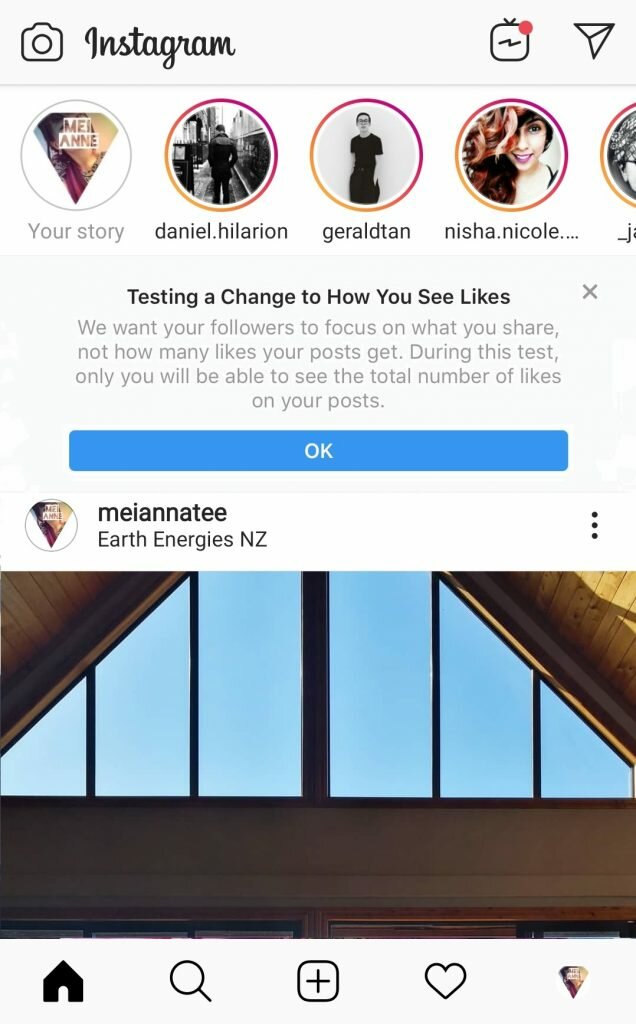I’ll be honest. I wasn’t exactly double-tapping when Instagram hid the like-count for users in New Zealand. About six months ago, I relocated from Singapore to this beautiful country ― one that values people’s wellbeing so much, it went on to produce the world’s first Wellbeing Budget, partly devoted to alleviating mental illness. I shouldn’t have been too surprised then that in mid-July 2019, a notification at the very top of my Instagram feed, now attuned to my new IP address, showed up.

It read, “We want your followers to focus on what you share, not how many likes your posts get. During this test, only you will be able to see the total numbers of likes on your posts.” Facebook-owned Instagram implemented the change for the benefit of users’ wellbeing in seven countries, including Australia and New Zealand. ‘We want Instagram to be a place where people feel comfortable expressing themselves,’ explained Mia Garlick, Facebook’s director of policy for Australia and New Zealand.
True enough, scrolling down, the effects of a kinder version of Instagram were clearly visible―or not. Instead of normally being able to preview the hundreds of likes A magazine would generally get on a photo it posts (#ReadAMag), I now see nothing. Okay, actually, I can still click and ascertain who liked someone’s posts but would have to count the list of likers myself. And missing, too, are my modest, lower-digit like counts I’d get on photos of my wanders, wine and dine, and feline encounters; on the backend, I am still able to discover the amount of likes I get for each of my own post―but presumably, no one else can.

So, why play this game of hide and seek? Why not abandon the red-heart button altogether? Well, the public tallying of likes has been the heart of the photo-sharing app and many other social media platforms as far back as we even remember. Even so, by merely hiding them, is Instagram digging its own like-less, lifeless grave?
Besides, receiving loads of likes can feel like getting an actual thumbs-up or a pat on the back for a job well done. It’s an instant, relatively useful bit of quantifiable feedback on your skills or creativity, or in my case, how well I managed to flatlay my brunch or write a winning, witty caption—or not.
Fine, I’m slowly seeing the appeal of not having to create content just for likes. I admit, when that all-important “scoreboard” was still visible, I’d constantly check up on the figures, increasing my urge to compare and would feel uncreative or unsupported when I don’t see a certain number of likes tabulated for my own post.
This is probably the reason why Instagram Stories was such a heaven-sent and a hit today. Users generally post more liberally with stories than they do with posts, partly due to the feature’s no-like-tallying policy.
Still, many critics have argued that removing likes on posts would deal those who use the app for business a crushing blow, especially influencers and the brands that hire them. Instagram said there’s no truth to the claim that removing likes is part of its plan to push advertising to the platform in the form of sponsored posts rather than promotions with influencers. Still, without public likes, businesses will struggle to gauge how well they can align their products or services with a targeted audience and eventually, may have to just pony up and pay Instagram for paid campaigns.

So, the question now is: Does the removal of likes mean the beginning of a beautiful new era of social media, or is it merely a step towards better monetising the platform? Dr Amanda J. Williamson, a lecturer in innovation and strategy at New Zealand’s University of Waikato, says, “How to manage this shifting landscape of paid endorsements is an interesting puzzle. It seems that a range of features have been rolled out by Instagram over the past year, aimed at better managing paid endorsements between brands and influencers. The trial of removing likes is a logical extension of this pipeline of experiments, based on monetising influencer-to-brand exchanges that are happening regardless of Instagram’s involvement. The removal of likes will likely allow influence and attention to be better managed and monetised on the platform moving forward. Lest we forget that, from a revenue perspective, Instagram is in the business of advertising.”
Nonetheless, from a personal standpoint, Williamson welcomes an Instagram without a like-count. “There is something highly appealing about the removal of likes.” She continues, “In the age of influencers and ever-growing social media platforms, our online exchanges could too easily reflect something from the TV series Black Mirror if we are not careful. I welcome experiments that explore new ways for growing more authentic and fewer Black Mirror-esque interactions on digital platforms.”
No news yet if a like-less Instagram will be rolled out worldwide but it’s undoubtedly an interesting first step—maybe even be the start of more “White Mirror” examples to come, where social media promotes the mental health of its users. I’d double-tap that.

